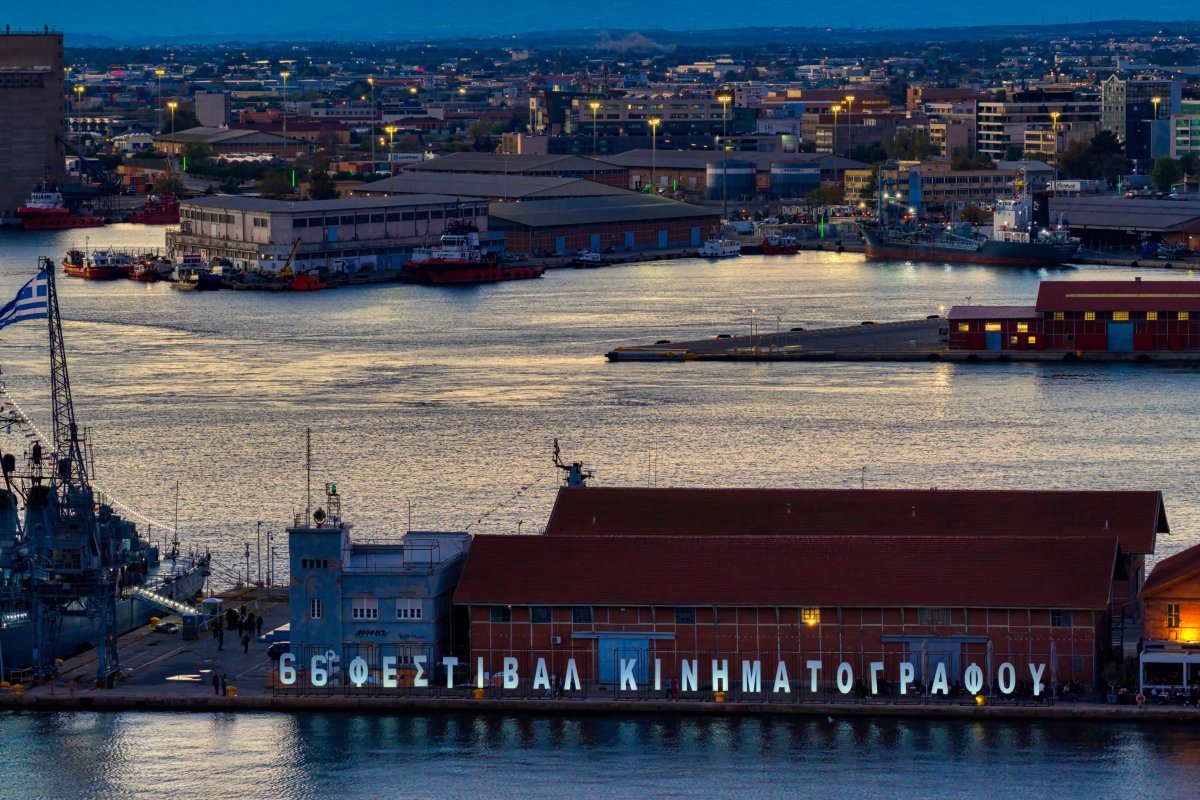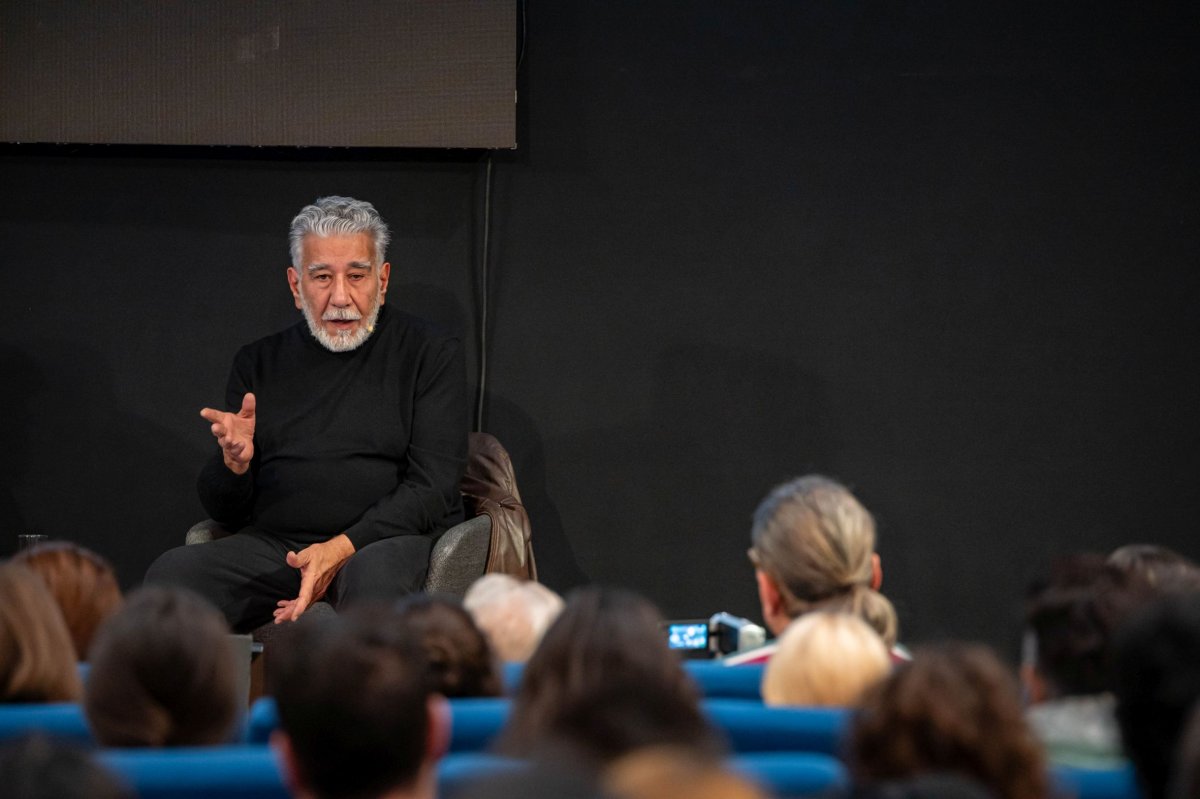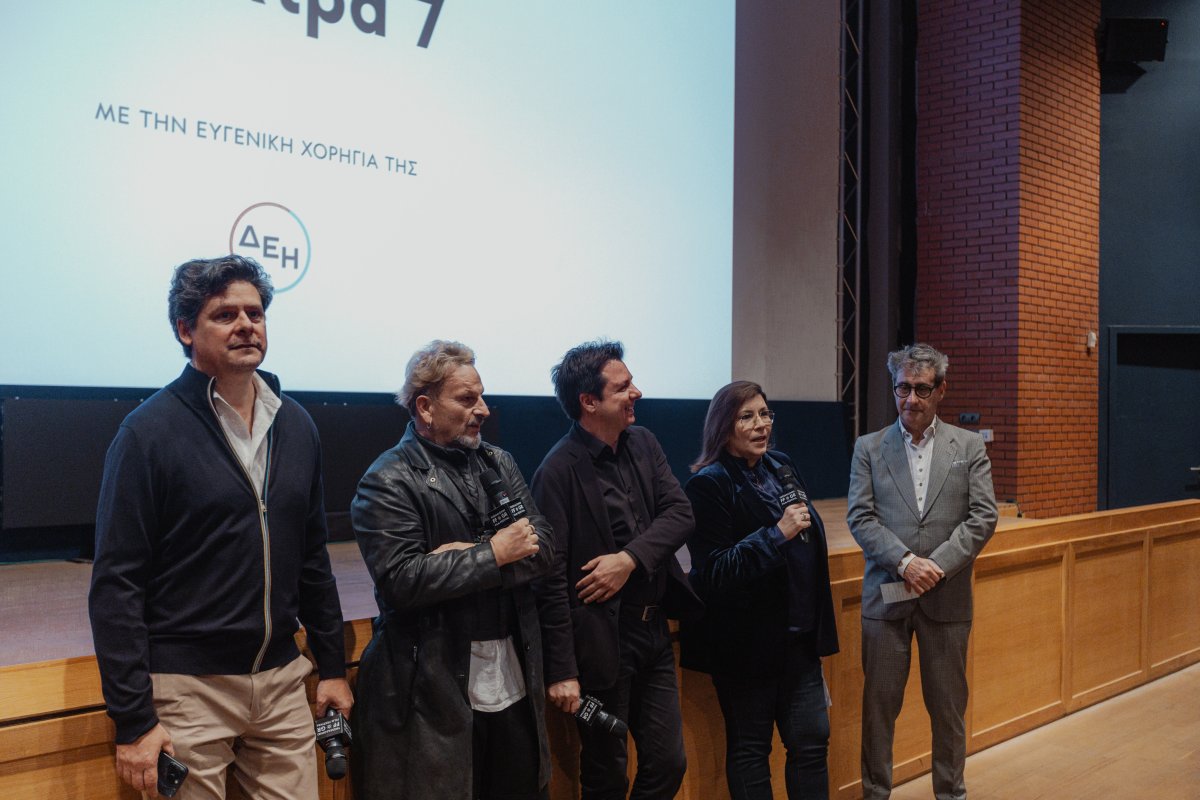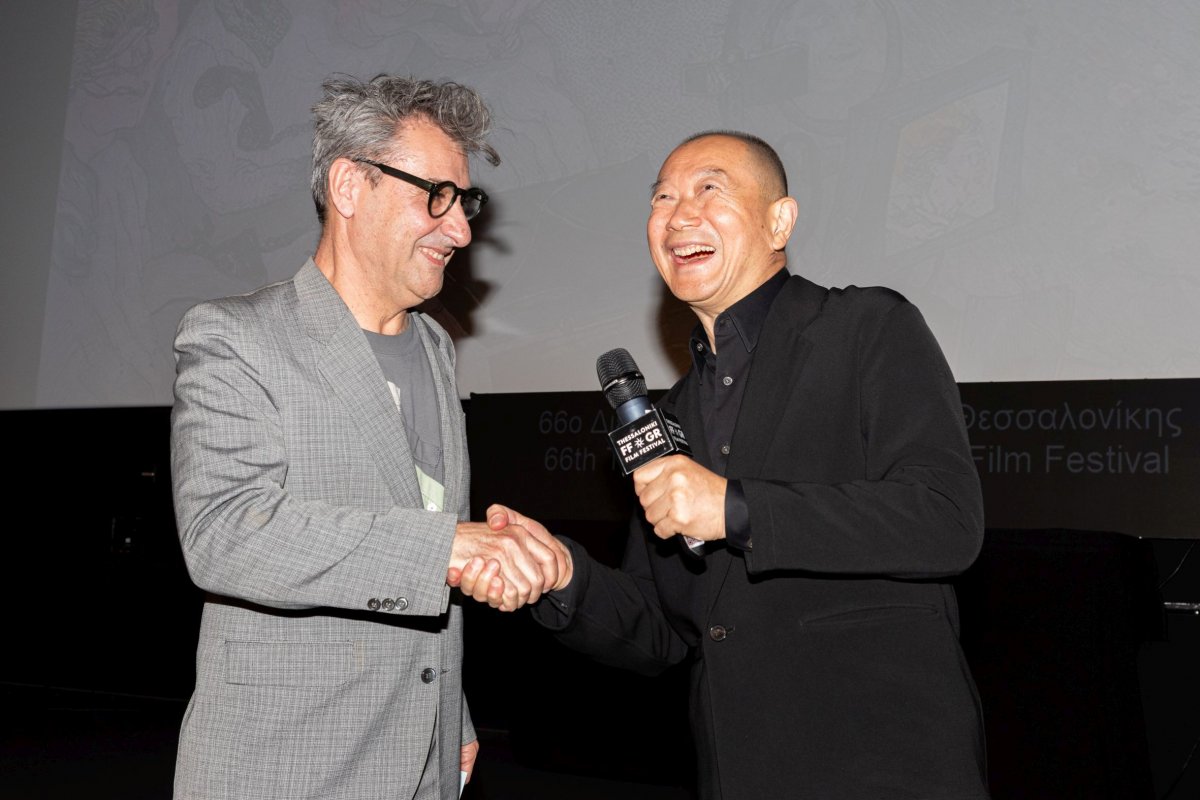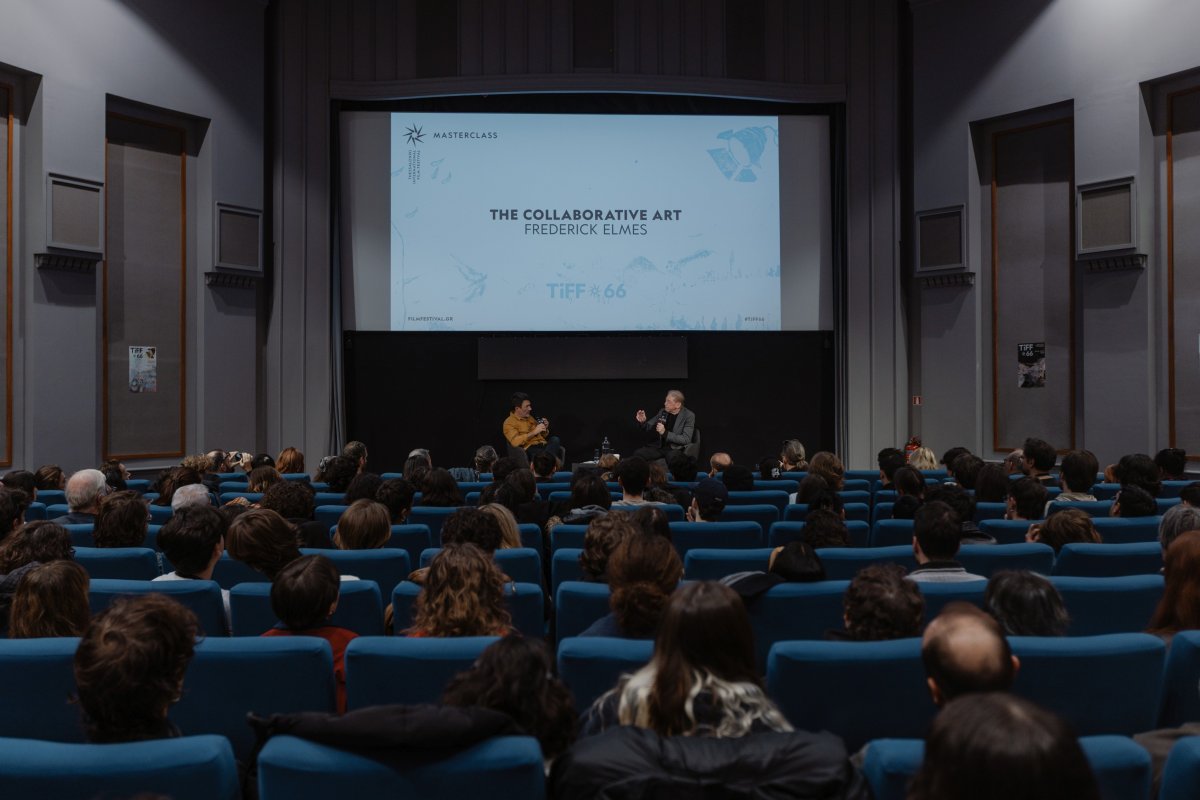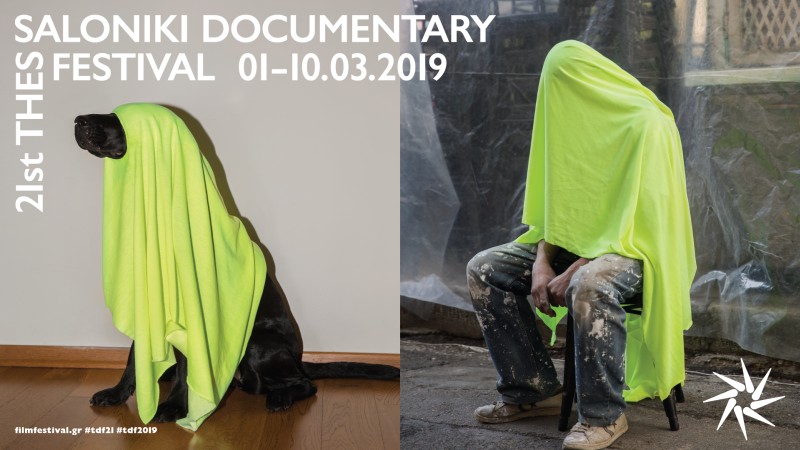The righteous decision of God for the liberation of Greece (no. 1)
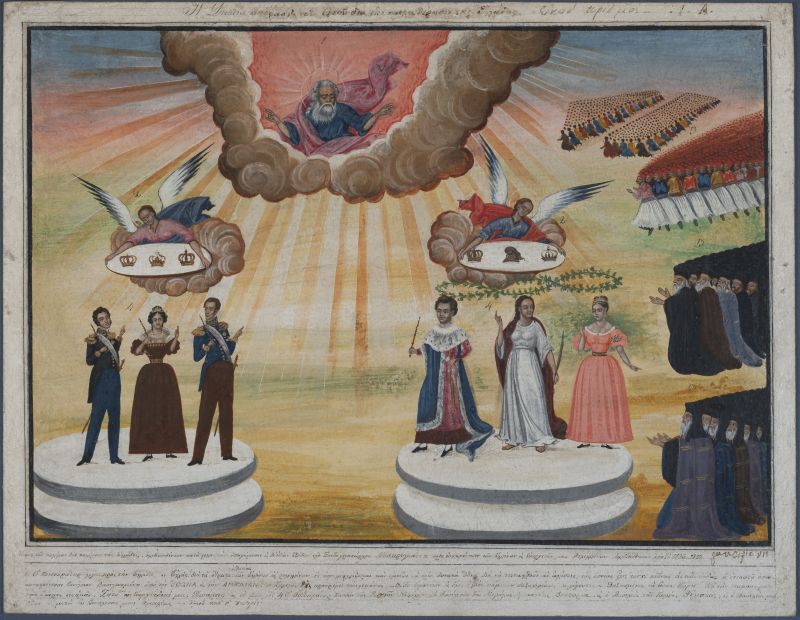
The strict hierarchy in the organization of this image, the placement of the figures on the canvas and the symbolic representation of Christ Pantocrator and the angels, are reminiscent of images of Byzantine imperial authority, i.e. temporal power granted by divine right. Thus, the image embodies the divine prescription and moral obligation bestowed to the Great Powers to protect Greece.
The monarchs depicted here (Nicholas I of Russia; Victoria of the United Kingdom of Great Britain and Ireland; Louis-Philippe of France; Otto and Amalia of Greece) were in power not during the time of the War of Independence, but in 1839 when the paintings were executed. In other words, they were the intended recipients of the paintings to whom General Makriyannis wanted to extend not only his gratitude but also an appeal for help to expel the Ottomans for good and to assist Greece at that particular moment.
Fall of Constantinople (no. 2)
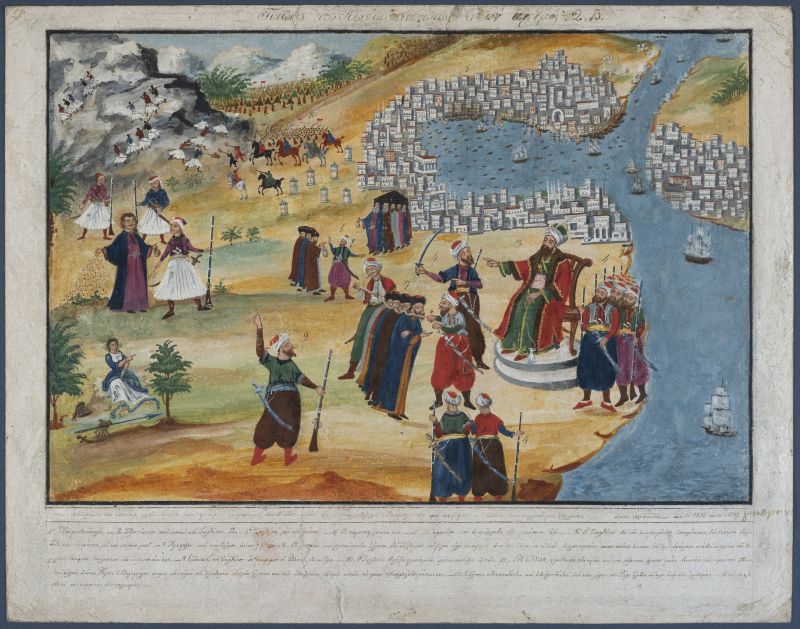
The image compresses the historical narrative in time and space. Placing the beginning of the calamities of Hellenism at the Fall of Constantinople in 1453, the narrative proceeds with the enslavement of the clergy and elites by the conqueror, highlights the resistance of the Greek people who are shown fighting on the mountains and ends with the activity of Rigas Velestinlis (1757-1798), whose works ignited the desire for freedom in the Greeks. In essence, this highly symbolic visual narrative functions as the historical introduction to the iconography of the War of Independence that follows.
Naval Battles of the Greeks (no. 3)
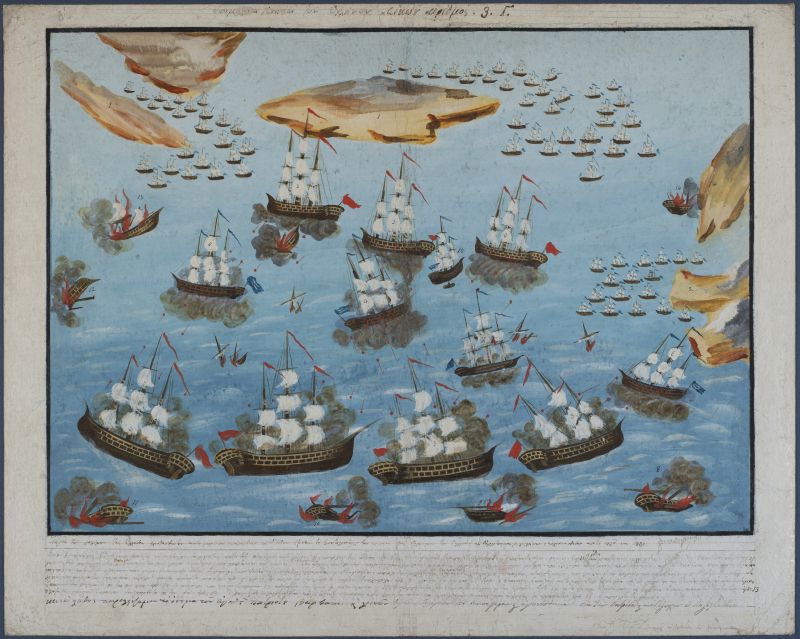
This collective imagery of various naval battles honors the insurrections at sea, especially the contribution of the fighters from the islands of Hydra, Spetses and Psara, who played a decisive role in the War of Independence offering their fleet and crews. In 1821 the commercial fleet of the Greek islands (about 300 ships with a total crew of 12,000 men) was fitted with cannons. To overcome their deficiencies in the number and size of battleships vis-à-vis the enemy, Greek seamen developed the fireship or “bourlot” technique in order to avoid head-on combat: a small ship was fitted with explosives, approached the enemy vessel and was set to the torch burning both the fireship and the hostile vessel. All ships have three masts; the Turkish vessels fly red flags while the Greek ones have white and blue flags.
The image portrays the first torching of a Turkish vessel in May 1821 when Demetrios Papanikolis set on fire the Turkish flagship at Eressos on the island of Lesbos, while on the lower right we see the celebrated torching of the Turkish flagship that was anchored in the harbor of Chios by captain Constantine Kanaris from Psara (June 1822). Tribute is also paid to the English-built steam-powered warship “Karteria,” under the command of the Philhellene captain Frank Abney Hastings (1794-1828), which took part in military combat in 1826.
First Battle of the Greeks against the Turks at the Bridge of Alamana; Death of Captain Diakos and the Archbishop of Salona Isaiah and other brave officers (no. 4)
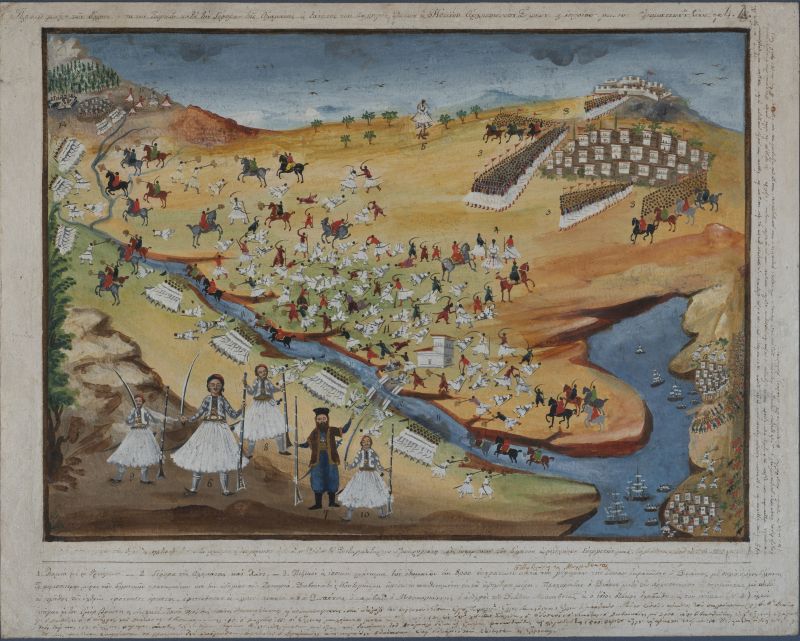
The painting represents three battles: the battle of Alamana (April 1821), where Athanasios Diakos was killed; a battle fought by Makriyannis and the forces of Panourgias in Patratziki against the forces of Mahmud Dramali Pasha (spring of 1822); and finally, the battle of Ypati (early May 1822) against Dramali Pasha.
The largest figure in the foreground is Athanasios Diakos. The bravery of another fighter, Nicholaos (or Mitros, as Makriyannis calls him in his “Memoirs”) Katharios from Kolovates is also singled out. Despite his serious injury, Katharios managed to fight four men at the same time. The rest of the action is presented summarily.
Battle at the Inn of Gravia (no. 5)
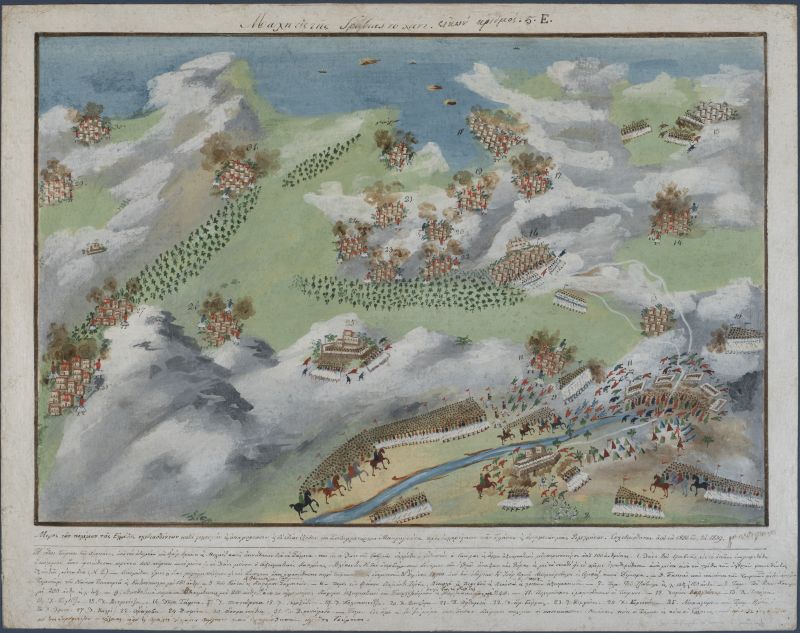
The fifth image describes the battle at the Inn of Gravia (May 8, 1821), the battle of Abliani (July 14, 1824), as well as various skirmishes between Greeks and Ottomans in the region. Following the battle of Alamana, Odysseas Androutsos barricaded himself at the Inn of Gravia with 120 men. The vanguard of Omer Vryonis, Pasha of Berat, attacked Androutsos who endured four assaults with minor losses. While the pasha was waiting for artillery reinforcements, Odysseas Androutsos dismantled part of the inn and sneaked out. In July 1824, Panourgias managed to hault a large Turkish army of 15,000 men from his stronghold at the village of Abliani located between Gravia and Salona.
Battle at Langada and Komboti (no. 6)
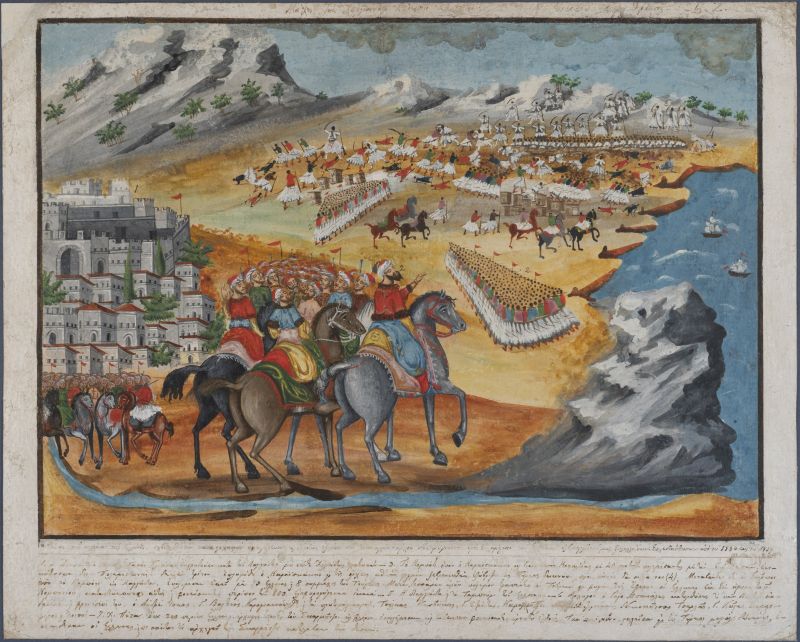
The sixth painting depicts various battles fought around the city of Arta in 1821. Tied up in Ioannina fighting its governor Ali Pasha, the Ottoman serasker (tur. commander-in-chief) Hurshid Ahmed Pasha sent Ishmail Pliasa Pasha to Western Greece in command of 1,800 men. The Greek warlord Andreas Iskos attacked Ishmail’s vanguard, which retreated and camped in Komboti (May 28, 1821). At the same location a few days later, George Karaiskakis along with Yannakis Koutelidas and 40 men fought against the Turkish troops.
Battle at Vasilika (no. 7)
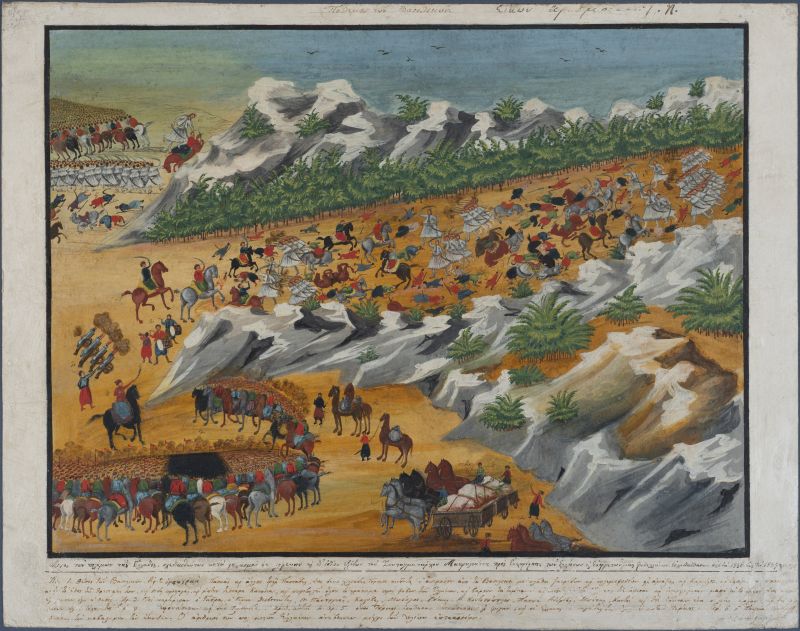
The victory of the Greeks at Vasilika in eastern Central Greece (August 26, 1821) was crucial for the War of Independence as it delayed the penetration of the Ottoman troops into the Peloponnese. Following the plan of General Yannis Dyovouniotis, the Greeks ambushed the Ottoman forces at the pass of Vasilika. The large Ottoman army of 8,000 men led by Bayram Pasha was on route from Macedonia to Tripolitsa so as to reinforce the defence of the seat of the Ottomans in the Peloponnese. The deafeat of the Ottomans at Vasilika bought time for the Greek chieftains of the Peloponnese to capture Tripolitsa and consolidate the gains of the Revolution in its genesis.
The image depicts the confusion during the armed combat, the triumph of the Greeks and the panic-striken Ottomans. Not even one foustanela-clad man lies on the battlefield, which is filled with bodies of foes. The artist was especially mindful in the way he drew the natural landscape, with the tall mountains on either side of the valley and the evergreen forest at its entrance.
Battle at Tripolitsa and the surrounding villages (no. 8)
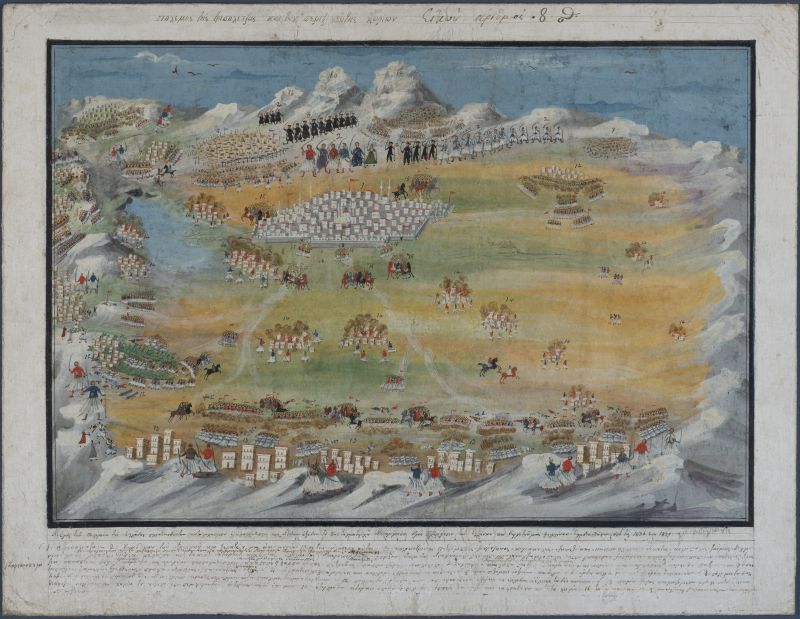
The siege of Tripolitsa, depicted in the center of the painting, lasted from April to September 1821. The systematic siege of Tripolitsa started with the battle of Valtetsi (May 12-13, 1821) and the push back of the enemy from Doliana, Vervena (May 18) and other neighboring areas. The besieged city fell to the Greeks on September 22, 1821; slaughter and plundering ensued.
The annotations mention the participation of the artist Dimitrios Zographos as well as that of the philhellene army officer Thomas Gordon (1788-1841) in the siege. Demetrios Ypsilandis stands out clad in European garb, while Laskarina Bouboulina is shown wearing a dark green dress, sword in hand. Other women are depicted as well, bringing water to the Greek army.
Various incidents such as the meeting of the military commanders, skirmishes in neighboring villages, and Ottoman sorties in order to replenish the city are depicted around the castle of Tripolitsa, which dominates the center of the painting. The design of the composition is set rhythmically in opposite directions: a centripetal movement from the outside towards the interior of the city (Greeks) and a centrifugal movement towards the opposite direction, from the inside out (Turks).
The Battle that took place in Arta (no. 9)
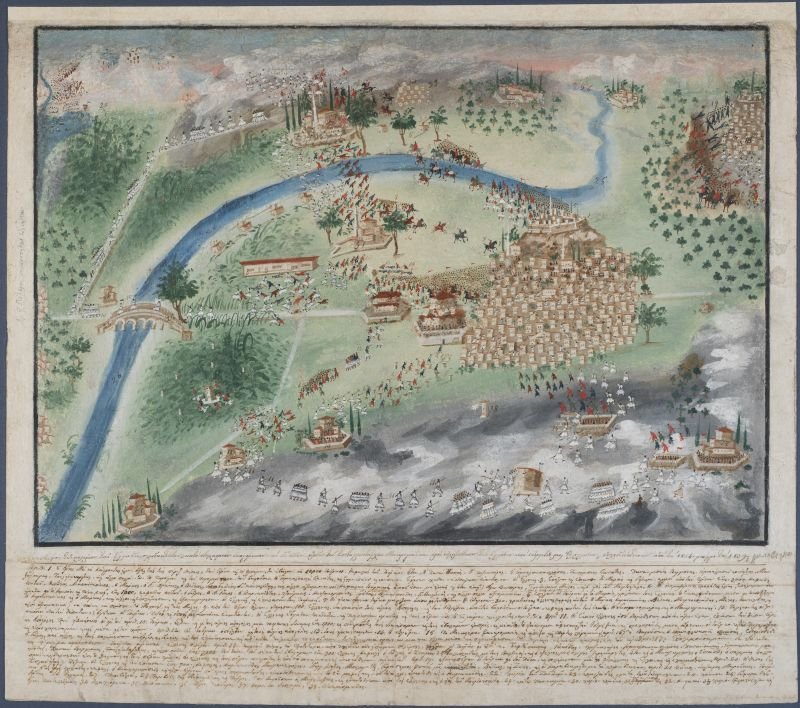
The capture of Arta was the first battle in which Makriyannis took part under the command of the warlord Gogos Bakolas, hence the extensive annotations. This painting depicts three battles that occurred in the area: the first battle of Peta (September 1821); the siege and capture of Arta (November 1821); and the heavy defeat of the Greeks in Peta on July 4, 1822.
In September 1821 the Turks of Arta attacked the village of Peta that was defended by Gogos Bakolas. During the battle Makriyannis was injured in the leg and gained the respect of his warlord, who assigned 100 men to Makriyannis’s command, despite the fact that the young man had joined the fight only a month before.
In November 1821 Arta was besieged and captured by the Greek forces in collaboration with several Albanian warlords. Violent plundering went on for sixteen days against the local population, regardless of their ethnicity or religion. Eventually, the Greeks retreated, slaughtering and looting Greeks and Turks alike, while Arta reverted to Ottoman hands. Makriyannis stood up to the injustices and the inhabitants of Arta adopted him as their chieftain.
After the death of Ali Pasha in January 1821, the whole of Epirus surrendered to Khursid Pasha except for Souli and the Greeks suffered a heavy defeat at Peta resulting in the regression of the Greek War of Independence.
First Battle of Athens (no. 10)
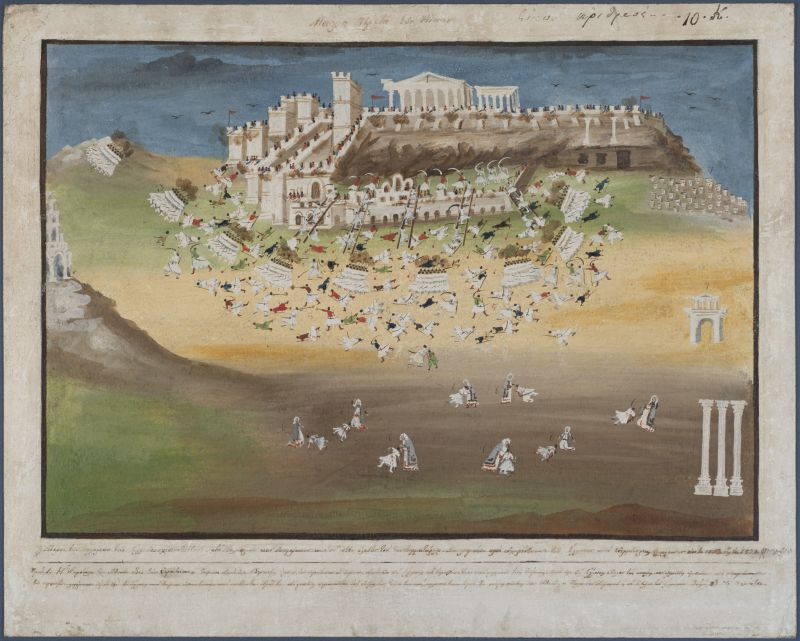
Although Athens had not shown any signs of revolutionary activity initially, the proclamation of the War of Independence in March rattled the local Turks who on April 9, 1821 incarcerated the twelve Athenian demogerontes (notables) in the tower “Koula” of the Acropolis,. Serfs from Mesogeia took up arms under the command of Demos Antoniou and stormed the city on April 25, 1821, forcing the Ottoman garrison to barricade itself inside the Acropolis. The siege dissolved upon the arrival of Omer Vryonis at Athens in July, but following his departure in November 1821 a new siege was laid to the Acropolis with the use of cannons and sapping. Exhausted by famine, thirst and the intense summer heat, the Ottomans finally surrendered on July 10, 1822. This second siege is depicted here.
The composition develops in a semi-circle around the rock of the Acropolis highlighting all major Athenian monuments (the Acropolis, the Columns of the Olympian Zeus, the Gate of Hadrian) in order to create a recognizable and yet dramatically appealing stage set. The image of women flocking to the battlefield to nurse the wounded warriors or mourn their dead is very touching.
Battles of Argos and Corinth and Agionori (no. 11)
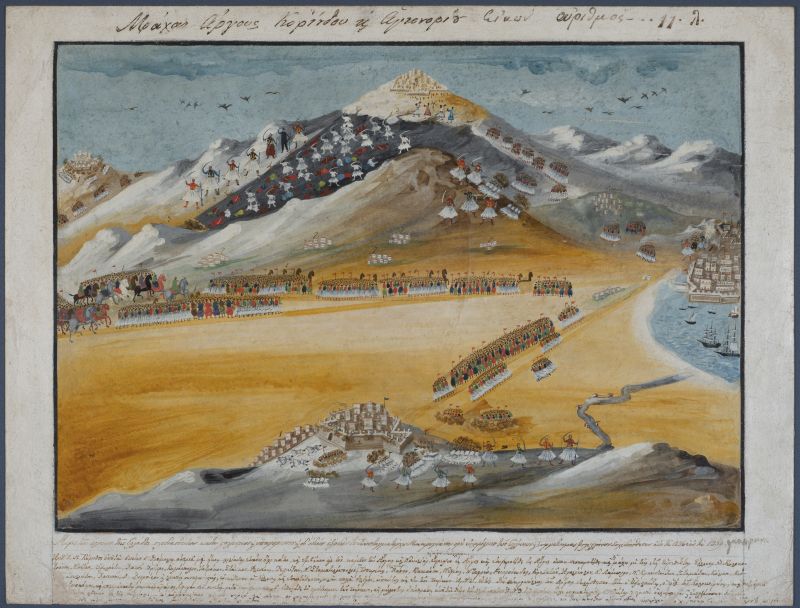
After eliminating Ali Pasha in Epirus, Khursid Pasha assembled a large military force to suppress the Greek Revolution under the command of Mahmud Pasha of Larisa (Dramali). The army of Dramali left Lamia at the end of June, crossed into Thebes, which it set on fire, and proceeded through Megara to the Isthmus of Corinth. Several castles were abandoned and fell into the hands of the Turks and when Dramali entered Argos (July 13), the city was almost deserted. Meanwhile, Theodoros Kolokotronis had camped in Myloi and reinforced the defense of Paliokastro, implementing the “scorched earth” strategy, taking all the supplies his army could carry and destroying the rest. Moreover, communication between Dramali and Khursid in Zitouni was hampered by the actions of Odysseas Androutsos and Makriyannis in Eastern Roumeli. Suffering from lack of food, Dramali’s great army was decimated by the Greek forces at the pass of Dervenakia on July 26, 1822. The castles reverted to Greek hands and Kolokotronis was proclaimed supreme commander.
The painting is set out in a symmetrical way with the two hilltops on top and a lot of empty space in the center of the image where the Turkish army is lined up.
Battles of the Greeks at Karpenisi and Kaliakouda (no.12)
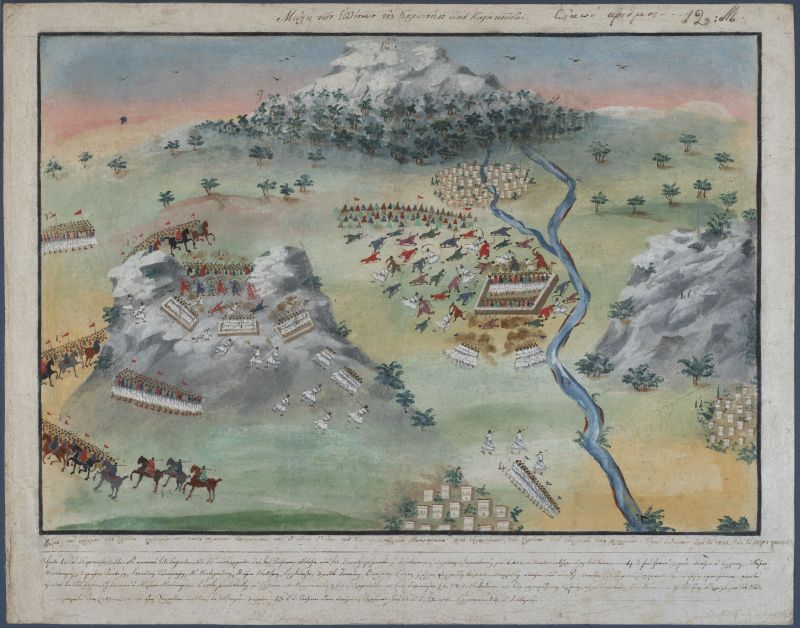
Two large Ottoman armies led by Mustai Pasha and Omer Vryonis marched towards Missolonghi in August 1823. The vanguard of Mustai Pasha camped at Karpenisi where the Greeks under Markos Botsaris launched a sudden night assault (August 5, 1823), during which Botsaris was shot dead. Other Greek troops delayed Mustai Pasha, but eventually he managed to join the army of Omer Vryonis and lay siege on Aitoliko in October 1823.
Sieges and Battles of Navarino (no.13)
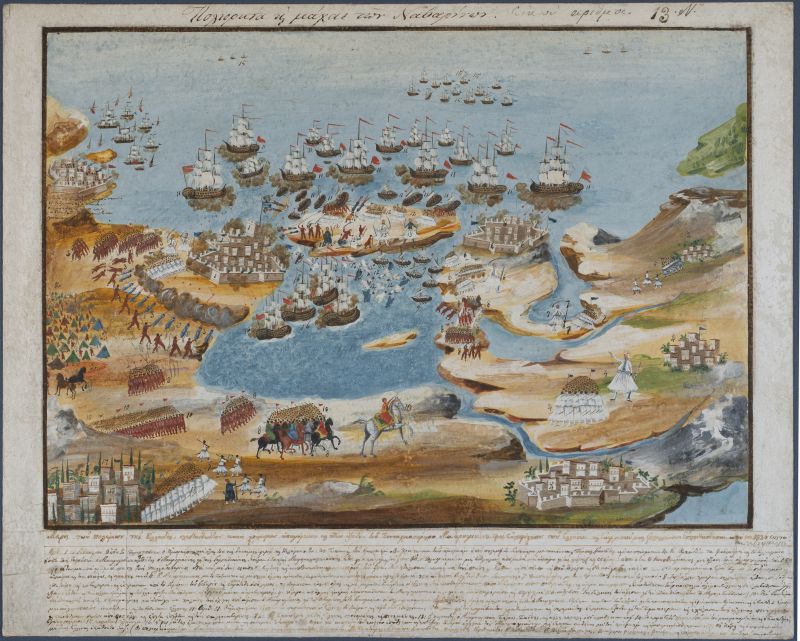
At the beginning of 1825 the Revolution appeared to prevail. The Sultan asked Ibrahim, son of Muhammad Ali, Pasha of Egypt to join the Ottoman forces with his well-trained army. After sacking Modon and Coron the formidable army of the Egyptians turned against Neokastron at the southern tip of the harbor of Pylos. Makriyannis was asked to help in the defense first of Paleokastron and then of Neokastron, and he also negotiated the terms of the surrender of Neokastron with Ibrahim. When Makriyannis’s men demanded wages and arms he paid them out of his own pocket.
This painting compresses many events within the same pictorial space. The narrative composition is complex and packed with action, while Makriyannis himself appears at least six times. The last mention of the General (“Headquarters and Koundoriotis with the Greeks sitting there”) implicitly criticizes various politicians, Koundouriotis in particular, who had refused to assist the defenders of the castle, resulting in the loss of the stronghold as well as many human lives.
Battle at the Myloi of Nauplion (no. 14)
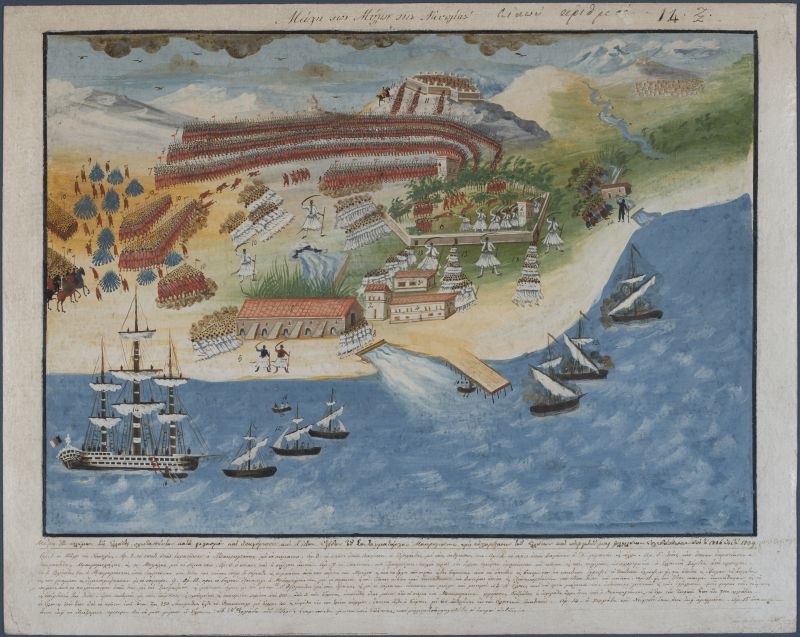
After their defeat in Pylos, the Greeks could not contain the joint Turko-Egyptian troops who marched towards Tripolitsa. The Greek forces led by Kolokotronis tried unsuccessfully to confront them at the narrow passes between the regions of Messenia and Arcadia. Anticipating that Ibrahim would then move against Nauplion and the Myloi of Lerna, which was a center for the supply and replenishment of the city, Makriyannis fortified the position by stocking plenty of food and water. Reinforcements from land and sea arrived two days later. The Greek forces defeated Ibrahim Pasha for the first time on Greek soil on June 13, 1825, but Makriyannis was seriously injured in his right arm. The Turko-Egyptian fleet turned its attention towards Missolonghi.
The drawing is quite naturalistic, while the landscape, boats, and figures are stylized as are also the groups of soldiers who move in geometrical masses without any single figure shown with individualized characteristics. The complex narrative requires the presence of the actors more than once. Ypsilandis, clad in western garb, is depicted in two places, while Makriyannis is shown four times. The itinerary of a boat is marked by the appearance of the vessel in three different places: at the dock, at sea, and next to the frigate.
Various Sieges at Missolonghi (no. 15)
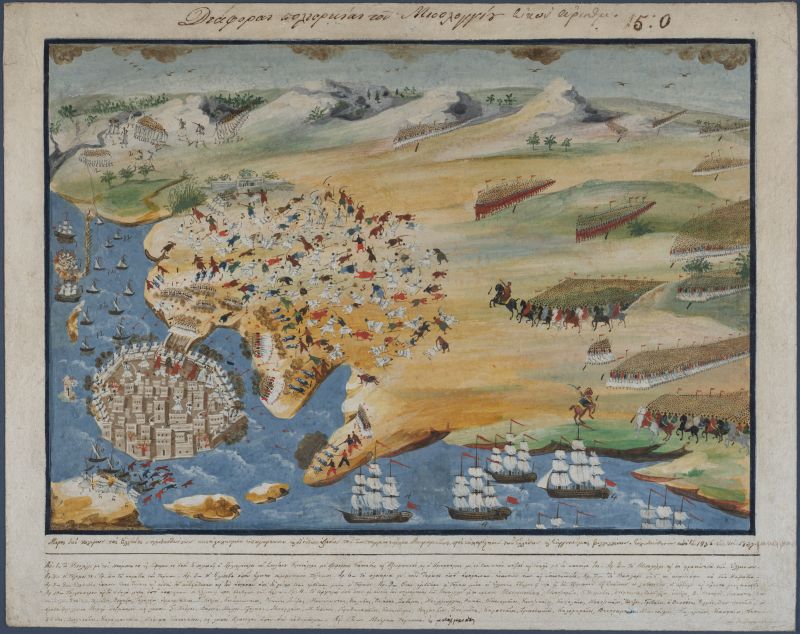
The town of Missolonghi had emerged as a stronghold of the revolution in western Greece, due to its natural fortified position and its proximity to the Peloponnese. The Ottomans besieged Missolonghi twice.
In 1822, Omer Vryonis and Reshid Mehmed Pasha (known as Kutahi) leading an army of 11,000 men camped outside Missolonghi while Yusuf Pasha set a sea blocade. In charge of the defense of the city was Alexandros Mavrokordatos with the help of Markos Botsaris and Kitsos Georgakis. Greek ships from Hydra and Spetses took advantage of the disagreements of the three Ottoman commanders about a common strategy, to break the blockade and succeed in replenishing the besieged. The Turks attempted a final assault on Christmas night, but their plans were betrayed and failed.
An even larger army under Kutahi Pasha lay the second siege of Missolonghi in 1825. The defense was even stronger this time: a ditch, bastions, and towers with firearms and mortars had been set up. However, once Ibrahim Pasha joined forces with Kutahi, Missolonghi was blocked from both land and sea. Hunger and exhaustion plagued the besieged, who attempted a heroic yet tragic sortie on Palm Sunday (April 10, 1826).
Battle of the Greeks at Arachova (no. 16)
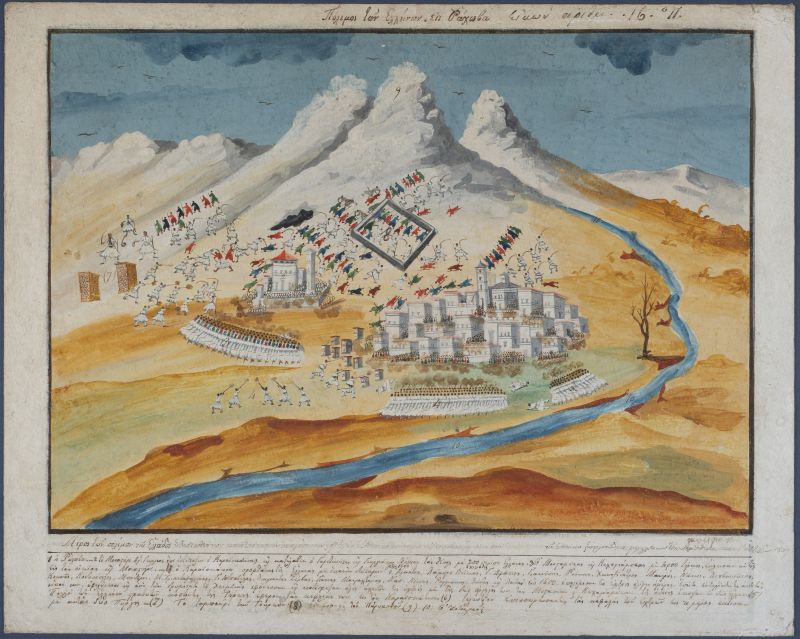
The fall of Missolonghi crushed all rebellious activity in western Greece and Kutahi marched against Athens in June 1826. Under the pressure of taxes levied by Yannis Gouras, who was governor of the city, the habitants in Chasia and Menidi in eastern Attica surrendered to Kutahi. In August, Gouras barricaded himself inside the Acropolis of Athens and the Greek government appointed George Karaiskakis as the commander-in-chief in eastern Central Greece. He regrouped the revolutionary forces in Eleusis and Salamis. Moreover, he dispatched a group of 200 men under the command of Alexis Gardikiotis Grivas and Georgios and Mitros Vagias to Arachova so as to attack the Ottoman army on their way to Salona (Amfissa), where he later joined them with his own forces. The 2,000 Turks of Mustafa Bey were indeed slaughtered in Arachova (November 17, 1826), whilst Greeks suffered minimal losses. The next day after the battle Karaiskakis’ men built two towers with the heads of 300 slaughtered enemies.
Battle at Analatos (no. 17)
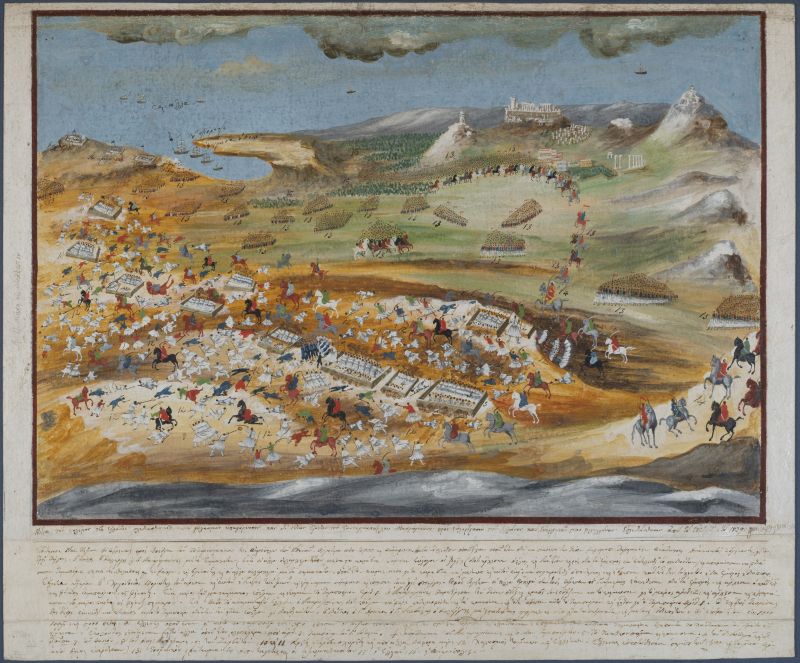
The battle of Analatos (modern Nea Smyrni) took place after the battle of Pireaus and Phaleron depicted in painting no. 18. In the time elapsed between the two events, the commander-in-chief George Karaiskakis had been killed in the battle of Phaleron, and replaced by Kitsos Tzavelas and Richard Church. The plan was to attack the Ottoman army in Athens from Phaleron in order to break the siege of Acropolis, but this was a dangerous strategy for the Greek troops, who had to cross a great distance on open, flat ground, exposed to numerically superior enemy forces and cavalry.
The planned attack was betrayed. Despite contrary advice (that proper redoubts were needed), Admiral Thomas Cochrane deployed his soldiers at Colias (modern Agios Kosmas) earlier than originally planned and the attack was launched. Kutahi’s cavalry and infantry attacked them between the Hill of Philopappus and the ancient Temple of Zeus. The casualties for the Greeks were devastating (about 2,000 men), the worse ever since the beginning of the Revolution.
Makriyannis was blamed for the disastrous defeat, but he repudiated and accused Cochrane and Kitsos Tzavelas who had left 9,000 men idle on the hills of Phaleron and Castella. Eventually, exhausted by the long siege and broken-spirited after the Analatos disaster, the Acropolis garrison was forced to surrender in May 1827.
This painting uses one-point perspective to show the size of each soldier with relation to his position in space and the artist gives depth and distance to the space between the battlefield and the city of Athens.
The names of Church, Cochrane, Kallergis, Makriyannis and Vasios are handwritten on the painting.
Battle at Pireaus (no. 18)
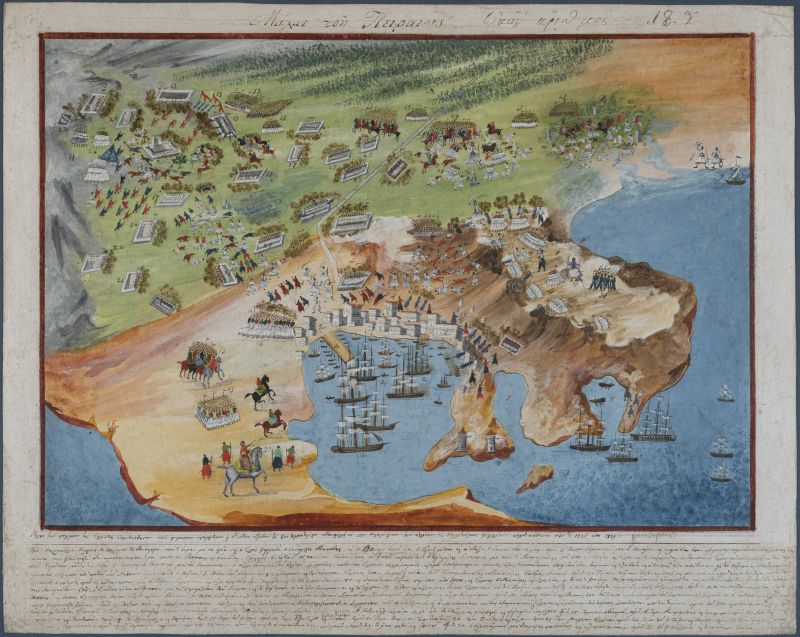
On November 17, 1826, Makriyannis left the garrison of the Acropolis of Athens (painting no. 19) to ask for help. He persuaded politicians, military men, naval officers and Philhellenes to set camp in Phaleron and assault the Ottomans who were besieging the Acropolis. On January 24, 1827 Makriyannis and others fortified Castella, while a second group, led by Vasos Maurovouniotis and Panagiotis Notaras was defeated by Kutahi in Kamatero on January 27.
Various skirmishes occurred between Greeks and Turks including a victory of Karaiskakis in Keratsini on March 4, 1827. Naval commander Lord Thomas Cochrane planned to launch a general head-on assault against Athens from Phaleron (Three Towers) in order to free the Acropolis; most warlords disagreed with his plan on the grounds that it would expose the Greek forces on the open field, but Cochrane imposed it by threat of resignation. Just before the general assault of April 22, George Karaiskakis’s death by enemy fire had a disastrous impact on morale and was partly the reason for the defeat of the Greeks in Analatos on April 24, 1827.
The Siege of Athens (no. 19)
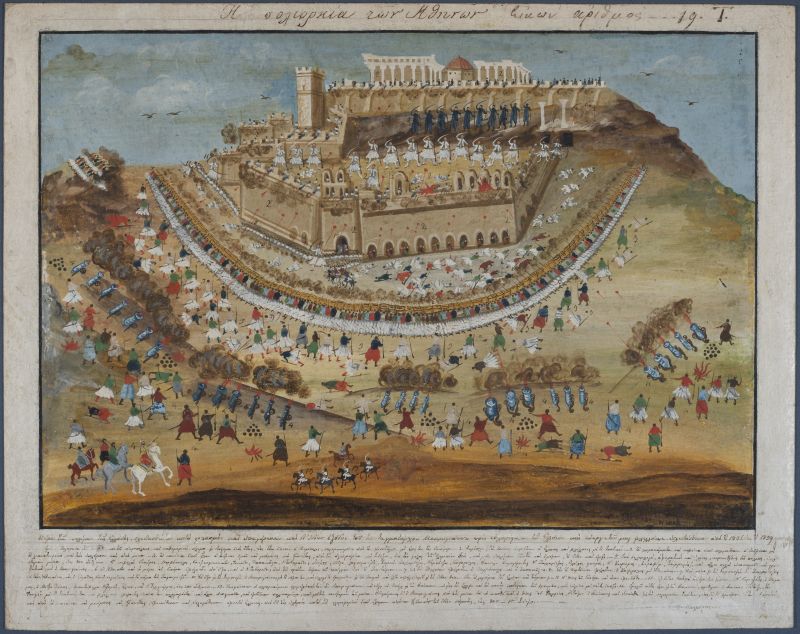
This picture depicts the events that took place during the second siege of Athens. The forces of Kutahi and Omer Vryonis besieged the citadel in the summer of 1826, while Makriyannis as Politarch and member of the city garrison defended the walls of Athens. After the death of castellan Gouras on October 1, the defense of the Akropolis was assigned to a governing committee, which included Makriyannis. He was posted at Serpentzes (the Odeon of Herodes Atticus), along with captain Dionysios Eumorphopoulos and Kostas Chormovitis Lagoumitzis [the sapper], an expert on explosives. Both sides used to dig mines, pack them with gunpowder, set them afire and cause explosions on the other side of the tunnel where the enemy lay. From this key-position, Makriyannis and his men managed to push back the greatest assault against the Acropolis, on October 7, 1826.
As the image suggests, Makriyannis broke the enemy blockade in order to appeal to the Government for help; he appears with a group of riders in three locations: at the entrance of the Odeon of Herodes Atticus, outside the Acropolis and outside the firing range of the enemy. The Acropolis garrison eventually capitulated in May 1827. Athens would be officially liberated in March 1833 upon the arrival of King Otto.
The composition is arranged in a semi-circular fashion echoing the outline of the rock. The pattern, the colors and movement strongly resemble folk embroidery. The multiple appearances of Makriyannis disrupt the time-space continuum, but seem essential for the progression of the narrative of events that span over a long period of time and attests to Zographos’s talent in handling space. He covers almost the entire pictorial space with moving figures.
The Naval Battle of Old Navarino (no. 20)
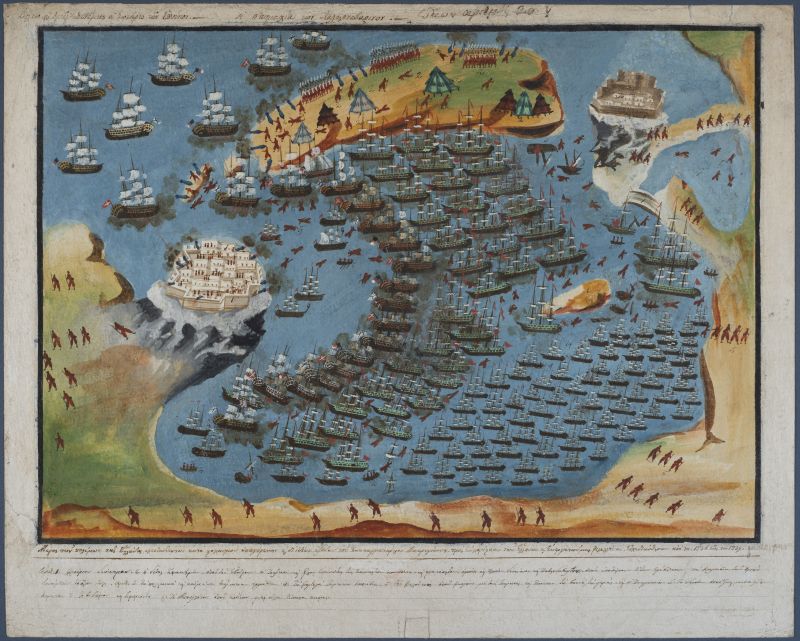
The success of Ibrahim Pasha and Kutahi in Missolonghi and Athens changed the stance of the Great Powers vis-à-vis the Greek War of Independence. In 1826 the Protocol of St. Petersburg called for the foundation of an autonomous Greek state, whereas the Treaty of London (July 6, 1827) demanded a truce and ceasefire; moreover, a secret clause allowed the European military forces to interfere in case the Ottoman Empire rejected the agreement. This diplomatic development led to the naval battle of Navarino (October 8/20, 1827), in which Ibrahim Pasha’s fleet was destroyed by allied forces from Britain, France and Russia. This event revitalized the withering Greek Revolution. Ibrahim Pasha was forced to sign a truce on the flagship of British Admiral Codrington.
In order to illustrate the naval battle, the artist manipulated the landscape and its features, such as the diminutive castles of Neokastron and Palaiokastron, and drew a more expansive maritime space.
Picture of Western Greece and Vonitsa at the center, around which many battles took place; the fighters that we remember are also depicted (no.21)
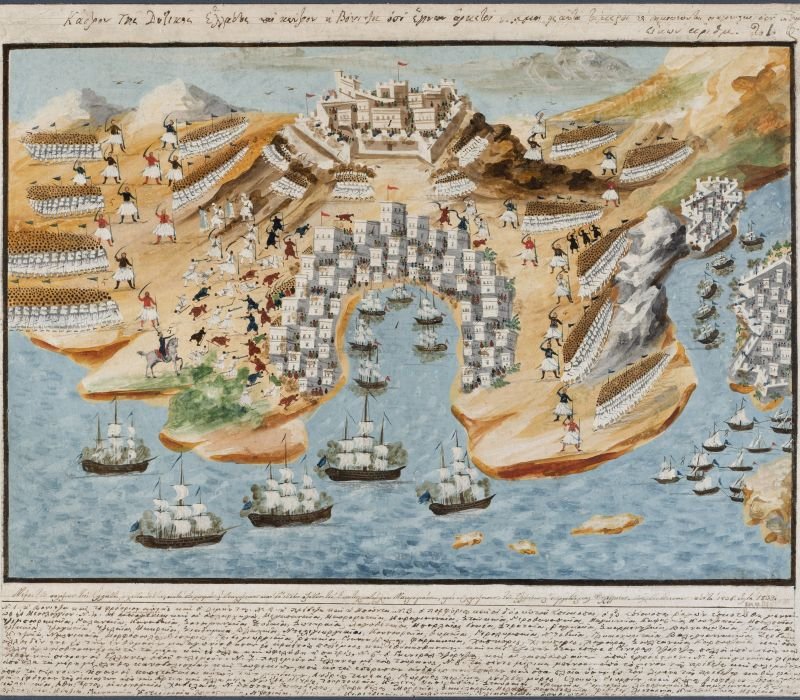
This illustration of Vonitsa, as well as the following one of Thebes (no. 22) are symbolic battle scenes, which do not depict a single event but illustrate many generic battles. The painting allows Makriyannis to recite the names of the men who fought in the western part of Central Greece; it commemorates the participation of women in the Greek Revolution, depicting them as they supply the men with water.
The geometric rendering of the image is dominated by the city of Vonitsa and its harbor, while Preveza appears nearby. Columns of warriors who fought in the area during the War of Independence are each preceded by its captain. The city was captured on December 15, 1828 by general commander Sir Richard Church with the help of the navy, while the Turkish garrison surrendered in March 1829.
Various Battles of Eastern Greece with Thebes in the center (no. 22)
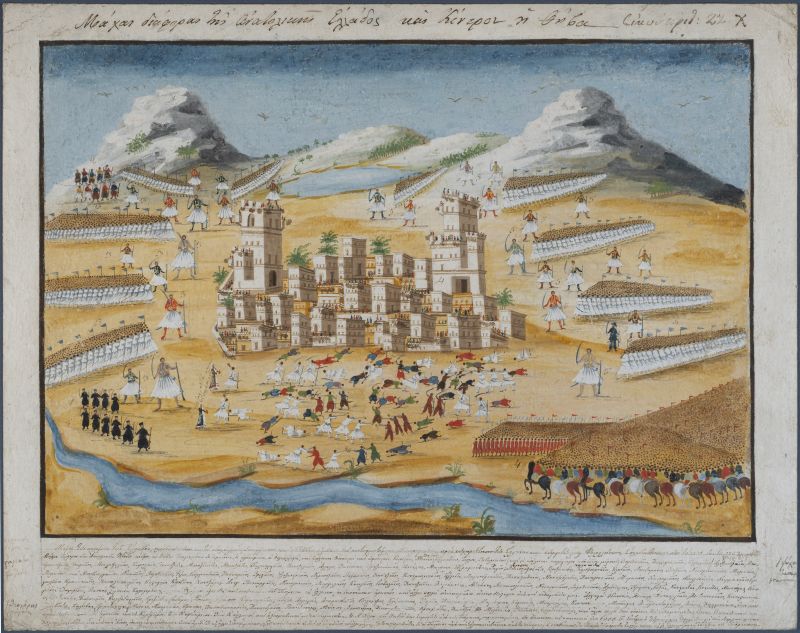
Upon his arrival to Greece in 1828 Governor Ioannis Capodistrias appointed Ypsilantis as commander of Eastern Greece. .The Governor created a regular army, the Officers Corps, which was partly mobilized by Ypsilantis in late August. Τhe Greek forces beat the Turks at the narrow passage of Petra in Boeotia. The Ottoman commander capitulated and the Greeks gained the area between Livadeia to Thermopylae and Alamana (September 14, 1829). In the summer of 1829, the Peloponnese, many of the Aegean islands, and a great part of Central Greece had been liberated.
The city of Thebes is located at the center of the composition between two cone-shaped hills at the background, while the warlords with their men are positioned around Thebes. The warlords are shown frontally as large single figures, while their men are shown as geometrical shapes creating a symmetry that gives rhythm to the whole composition.
Battles of Crete and Samos (no. 23)
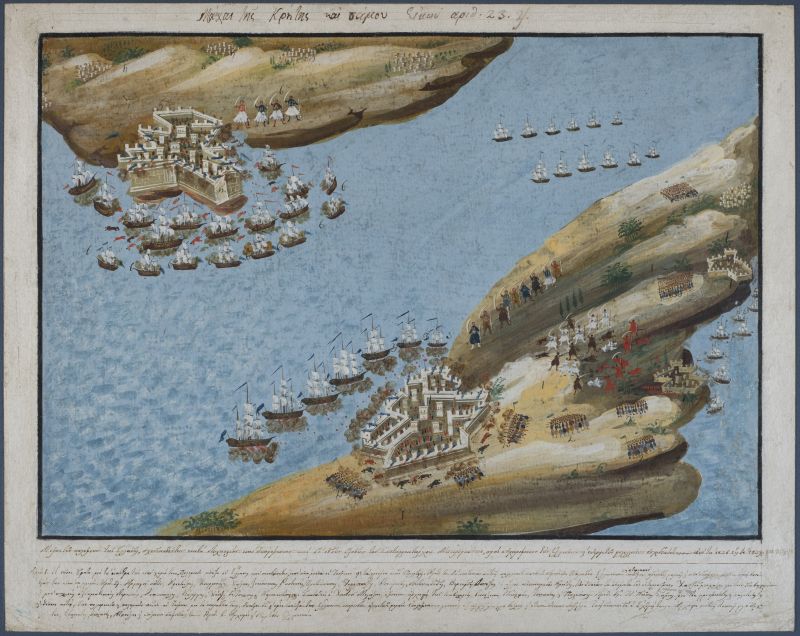
The Greeks of Crete revolted against the Ottomans with an attack at the village of Loulos in Chania on June 14, 1821. In retaliation, the Ottomans executed religious leaders, priests, monks, and laymen. In the spring of 1824, reinforcements from Egypt led to the suppression of the revolution in all parts of the island. A year later, however, the rebellion broke out again and by 1829 the whole of Crete was freed, except for three large castles in Chania, Rethymnon, and Heraklion.
The island of Samos had been self-governed since the 16th century. On April 18, 1821 the local population at Vathy joined the Revolution. With their men and the support of the Greek fleet they repelled the Ottomans in 1821, while at the naval battle of Gerontas off the coast of Samos (August 29, 1824) Admiral Miaoulis defeated the Turko-Egyptian fleet, secured Samos and achieved the greatest naval victory of the Greek Revolution. However, the Protocol of Independence of Greece signed in London (22 January/3 February 1830), excluded both Crete and Samos from the areas to be ceded to the newly established Greek state.




